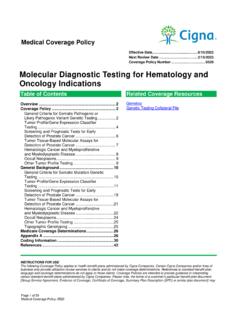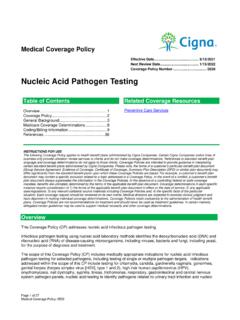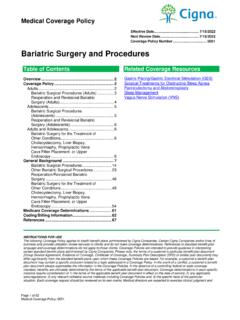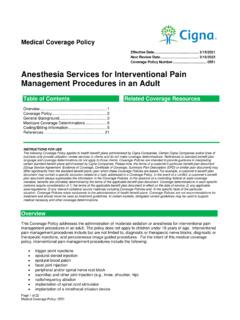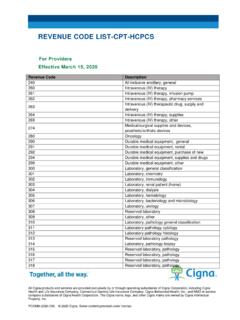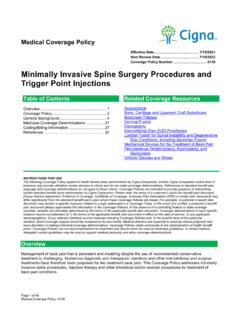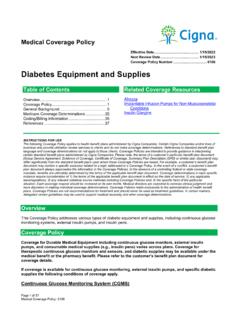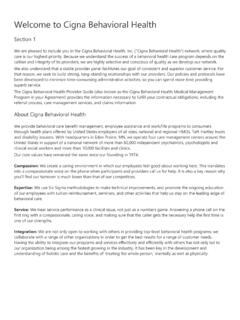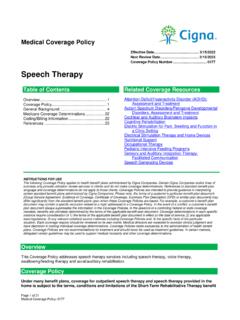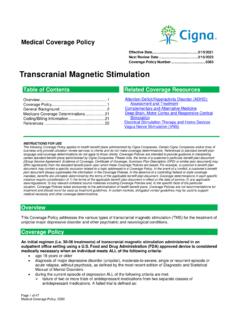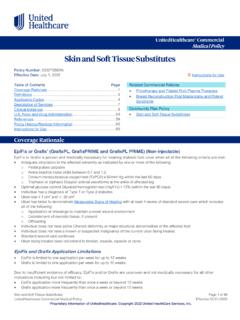Transcription of Botox CCRD Prior Authorization Form - Cigna
1 Botox Fax completed form to: (855) 840-1678 (botulinum toxin type A). If this is an URGENT request, please call (800) 882-4462. ( ). PHYSICIAN INFORMATION PATIENT INFORMATION. * Physician Name: *Due to privacy regulations we will not be able to respond via fax with the outcome of our review unless all asterisked (*) items Specialty: * DEA, NPI or TIN: on this form are completed.*. Office Contact Person: * Patient Name: Office Phone: * Cigna ID: * Date of Birth: Office Fax: * Patient Street Address: Office Street Address: City: State: Zip: City: State: Zip: Patient Phone: Urgency: Standard Urgent (In checking this box, I attest to the fact that applying the standard review time frame may seriously jeopardize the customer's life, health, or ability to regain maximum function). Medication requested: Botox 50 unit vial Botox 100 unit vial Botox 200 unit vial Total Dose Requested: Frequency of Administration: Quantity: List all muscles/sites that Botox will be injected at and list number of units being injected ( 30 units in trapezius muscle): into _____ into _____.
2 2. _____units into _____ into _____. 3. _____units into _____ into _____. 4. _____units into _____ into _____. into _____ into _____. Duration of therapy: J-Code: CPT Code: ICD10: Is this for new therapy or continued therapy? If your patient has already begun treatment with drug samples of Botox , please choose "new start of therapy". new therapy continued therapy (if continued therapy) Is your patient having a beneficial clinical response to Botox therapy? Yes No (if continued therapy) Please provide past treatment dates/doses/frequency with Botox , documentation of clinical improvement and duration of benefit. Where will this medication be obtained? Accredo Specialty Pharmacy** Retail pharmacy Prescriber's office stock (billing on a medical claim form) Home Health / Home Infusion vendor Other (please specify): ** Cigna 's nationally preferred specialty pharmacy **Medication orders can be placed with Accredo via E-prescribe - Accredo (1640 Century Center Pkwy, Memphis, TN 38134-8822 | NCPDP.)
3 4436920), Fax , or Verbal Facility and/or doctor dispensing and administering medication: Facility Name: State: Tax ID#: Address (City, State, Zip Code): Is the requested medication for a chronic or long-term condition for which the prescription medication may be necessary for the life of the patient? Yes No Please provide the diagnosis Botox is being used to treat and answer additional below questions as necessary. Diagnosis: _____. Diagnoses are grouped by condition type (Neurological, Gastrointestinal, Exocrine, Ophthalmologic, and Urologic). Neurologic Conditions Blepharospasm **This diagnosis requires supportive documentation ( chart notes, lab/test results, etc). Supportive documentation for all answers must be attached with this request. ** If NEW TO Cigna or precertification is now required, all information must be provided. Does your patient have intermittent or sustained closure of the eyelids caused by involuntary contractions of the orbicularis oculi muscle?
4 Yes No Is the requested drug prescribed by, or in consultation with, a neurologist or ophthalmologist? Yes No Cervical dystonia, including spasmodic torticollis **This diagnosis requires supportive documentation ( chart notes, lab/test results, etc). Supportive documentation for all answers must be attached with this request. ** If NEW TO Cigna or precertification is now required, all information must be provided. Does your patient have involuntary, simultaneous activation of agonist and antagonist muscles of the neck and shoulder (for example, sternocleidomastoid, splenius, levator scapulae, trapezius, semispinalis, scalene)? Yes No Does your patient have sustained head torsion and/or tilt with limited range of motion in the neck? Yes No Is the requested drug prescribed by, or in consultation with, a board certified pain management specialist, a neurologist or a physical medicine and rehabilitation physician? Yes No Migraine Prevention **This diagnosis requires supportive documentation ( chart notes, lab/test results, etc).
5 Supportive documentation for all answers must be attached with this request. ** If NEW TO Cigna or precertification is now required, all information must be provided. Prior to Botox , how many HEADACHE days per month is/was your patient experiencing? _____. Prior to Botox , how many hours per day do/did your patient's headaches last? _____. (if continued therapy) Has your patient had a reduction in monthly migraine days or hours? Yes No (if no) Has your patient had a reduction in days requiring acute migraine-specific treatment? Yes No Has your patient been treated in the past with any of the following? (check all that apply). antiepileptic drugs (divalproex, sodium valproate, topiramate). antidepressants (amitriptyline, venlafaxine). beta blockers (atenolol, metoprolol, nadolol, propranolol, timolol). none of the above Please include drug name and strength, date(s) taken and for how long, and what the documented results were of taking each drug checked.
6 Is there a documented contraindication per FDA label OR reason your patient is not a candidate for any of the following? (check all that apply). antiepileptic drugs (divalproex, sodium valproate, topiramate). antidepressants (amitriptyline, venlafaxine). beta blockers (atenolol, metoprolol, nadolol, propranolol, timolol). none of the above Please include drug name and the documented reasons your patient is unable to use that drug / drug class. While taking Botox , will your patient also use a CGRP inhibitor (Aimovig, Ajovy, Emgality, Vyepti) for preventative treatment of chronic migraine during the same time period? Yes or Possbily No Unknown (if Yes or Possibly) Prior to starting combination therapy with a CGRP, did/does your patient continue to experience 4 or more migraine headache days per month? Yes No (if Yes or Possibly) Prior to starting combination therapy did your patient try either of the following: A minimum 3 month trial of Aimovig, Ajovy, Emgality, or Vyepti A minimum 6 month trial (2 injection cycles) of onabotulinumtoxinA ( Botox ).
7 No or Unknown Please provide details of previous medications tried, results, and provide clinical rationale for concurrent use of these drugs. Is the requested drug prescribed by, or in consultation with, a board certified pain management specialist or a neurologist? Yes No Essential tremor (head, neck, hand, and voice). Is the condition disabling? Yes No Is the requested drug prescribed by, or in consultation with, a board certified pain management specialist, a neurologist or a physical medicine and rehabilitation physician? Yes No Focal Dystonias Check all that apply: focal hand dystonia (for example, writer's cramp). adductor spasmodic dysphonia/laryngeal dystonia Jaw-closing oromandibular dystonia Meige's syndrome/cranial dystonia (blepharospasm with jaw-closing oromandibular cervical dystonia). Is the requested drug prescribed by, or in consultation with, a board certified pain management specialist, a neurologist, an otolaryngologist, or a physical medicine and rehabilitation physician?
8 Yes No [For focal hand dystonia] Is your patient's condition causing persistent pain or interfering with the ability to perform age-related activities of daily living? Yes No Spasm/palsies Check all that apply: Hemifacial spasms Seventh cranial nerve palsy (Bells Palsy). Gaze palsies Is the requested drug prescribed by, or in consultation with, a board certified pain management specialist, a neurologist or a physical medicine and rehabilitation physician? Yes No [For Gaze palsies] Is your patient experiencing persistent pain or vision impairment? Yes No Spastic Conditions Check all that apply: Cerebral Palsy (including spastic equinus foot deformities). Cerebrovascular accident Localized adductor muscle spasticity in multiple sclerosis Spinal cord injury Traumatic brain injury Hereditary spastic paraplegia Upper limb spasticity (ULS). Lower limb spasticity (LLS). Is the requested drug prescribed by, or in consultation with, a board certified pain management specialist, a neurologist or a physical medicine and rehabilitation physician?
9 Yes No (if LLS) Is there documentation that your patient has had a significant decrease of function or ADLs* (for example, walking)? Yes No (if ULS) Is there documentation that your patient has had a significant decrease of function or ADLs* (for example, eating, washing)? Yes No *Activities of Daily Living Other (please specify): Gastrointestinal Conditions Chronic anal fissure Has your patient failed conventional non-surgical treatment (for example, nitrate preparations, sitz baths, stool softeners, bulk- forming agents, diet modifications)? Yes No If yes, please specify which medications were tried. _____. Is the requested drug being prescribed by, or in consultation with, a gastroenterologist or a surgeon? Yes No Hirschsprung disease Is Botox being used to treat obstructive symptoms due to a non-relaxing internal anal sphincter following surgery? Yes No Is the requested drug being prescribed by, or in consultation with, a gastroenterologist or a surgeon?
10 Yes No Primary esophageal achalasia Does your patient have any of the following? (check all that apply). Concomitant illness and/or high risk for complications from myotomy or dilation Poor response to Prior myotomy or dilation History of perforation caused by previous pneumatic dilatation Epiphrenic diverticulum Is the requested drug being prescribed by, or in consultation with, a gastroenterologist? Yes No Other (please specify): Exocrine Conditions Glandular section Check all that apply: cholinergic-mediated secretions associated with a fistula (for example, parotid gland, pharyngocutaneous). sialorrhea (excessive salivation) associated with cerebral palsy sialorrhea (excessive salivation) associated with parkinsonism other (please specify): (if fistula) Is the requested drug being prescribed by, or in consultation with, a dermatologist, an endocrinologist, a neurologist or an otolaryngologist? Yes No (if sialorrhea) Is the requested drug being prescribed by, or in consultation with an endocrinologist, a neurologist, or an otolaryngologist?
